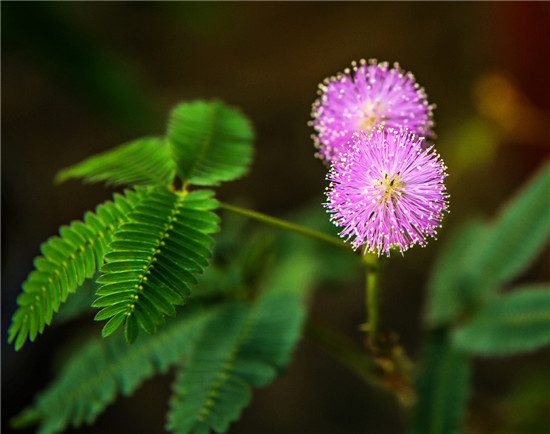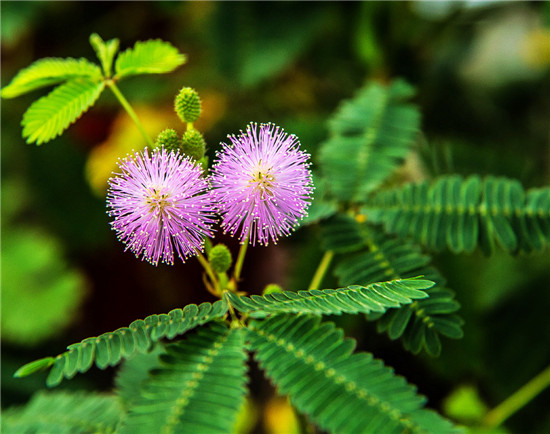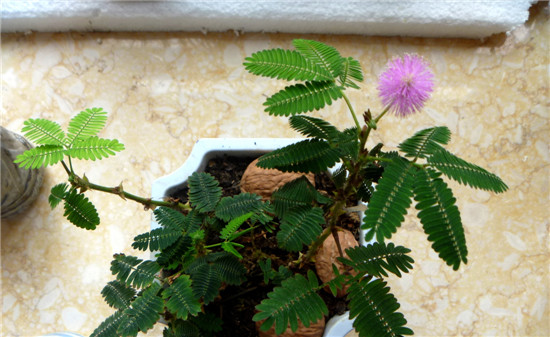Information on Mimosa Mimosa information summary
Mimosa, native to tropical America, is a perennial herb of the genus mimosa of Leguminosae. Because of its unique physiological habits, it has many aliases, such as "shy grass, knowledge mimosa, laughing grass, husband and wife grass" and so on.

The most obvious feature of mimosa is that when it is stimulated (such as touching), the leaves of mimosa contract immediately and come together. If the stimulation is strong, it will soon be transmitted to the adjacent leaflet or even the leaflet of the real compound leaf, making the petiole droop. Mimosa also responds quickly to stimuli, which usually begins to respond after 0.1 seconds and is completed in a few seconds.
The second characteristic of mimosa is that mimosa closes its leaflets at night, its petiole droops, and in the daytime, when some of its leaflets are shaken, it closes in pairs.
The third characteristic of mimosa is that it is classified as grass in many places because of its strong vitality and messy growth. in fact, it will blossom. Its flowers are pink and its head is spherical in shape like a fluffy ball. Pods will be grafted after flowering, and the fruit is flat and round.

Culture methods of mimosa
The best propagation time: Mimosa can be sowed all the year round, generally sowing from late March to early April, but it is best to sow in the pot in early spring and February.
The best growing soil: mimosa is suitable for sandy loam with good drainage and rich in organic matter.
Growth humidity requirements: the suitable humidity for mimosa life is about 70%.
The best growth temperature: mimosa is suitable for growing in a warm environment, between 20 degrees Celsius and 28 degrees Celsius, and stop growing if the temperature is too low. In winter, because the temperature is too low, it is necessary to water less to avoid freezing damage to the rhizome. Watering should be watered when the temperature is higher in a day. If the temperature is lower than 10 degrees Celsius, it is best to give certain protective measures.
Best growth light: mimosa likes sunlight and is best placed on a sunny balcony or window. Full exposure to sunlight is good for mimosa growth. If there is too little sunlight, it may hinder its growth.

The reason why mimosa is shy
1. The special ability of mimosa has its historical roots. It is native to Brazil in tropical South America, where there are often strong winds and heavy rain. Whenever the first drop of rain hits the leaf, the leaf immediately closes and the petiole droops to avoid the damage caused by the storm.
This is a kind of adaptation to the change of external environmental conditions. In addition, the exercise of mimosa can also be seen as a way of self-defense. When an animal touches it, it closes its leaves, and animals dare not eat it any more.
2. The drooping of the compound leaf of mimosa is caused by the change of cell tension in the pillow at the base of the petiole of the compound leaf. The structure of the cells in the upper part of the leaf occipital is different from that in the lower part, the cell wall in the upper part is thicker and the lower part is thinner, and the cell gap in the lower part is larger than that in the upper part.

Under the influence of external stimulation, the permeability of the cells in the lower part of the leaf occipital increased, and the water and solute were released from the vacuole and discharged into the intercellular space. Therefore, the tension of the lower tissue cells decreased and the tissue was weak, while the upper part of the tissue remained tense at this time. The petiole of the compound leaf is drooping.
The mechanism of lobular movement is the same, except that the structure of the cells in the upper and lower parts of the leaflet pillow is exactly the opposite to that of the leaf pillow at the base of the compound leaf petiole, so when the tension changes and part of the tissue is weak, the lobules close together in pairs.
The above is my summary of mimosa information, mimosa data collection of all the contents, I hope this article can help you. Please continue to follow us.
- Prev

The editor introduces you how to grow Persian chrysanthemum and how to plant it.
The editor introduces you how to grow Persian chrysanthemum and how to plant it.
- Next

[Acacia flower language] what is the flower language of Acacia flower
[Acacia flower language] what is the flower language of Acacia flower
Related
- Wuhan Hospital Iron Tree Blooming Result Was Instantly Frightened by the Gardener Master
- Which variety of camellia is the most fragrant and best? Which one do you like best?
- What is the small blue coat, the breeding methods and matters needing attention of the succulent plant
- Dormancy time and maintenance management of succulent plants during dormancy
- Minas succulent how to raise, Minas succulent plant pictures
- What are the varieties of winter succulent plants
- How to raise succulent plants in twelve rolls? let's take a look at some experience of breeding twelve rolls.
- Attention should be paid to water control for succulent plants during dormant period (winter and summer)
- Watering experience of twelve rolls of succulent plants
- Techniques for fertilizing succulent plants. An article will let you know how to fertilize succulent plants.

